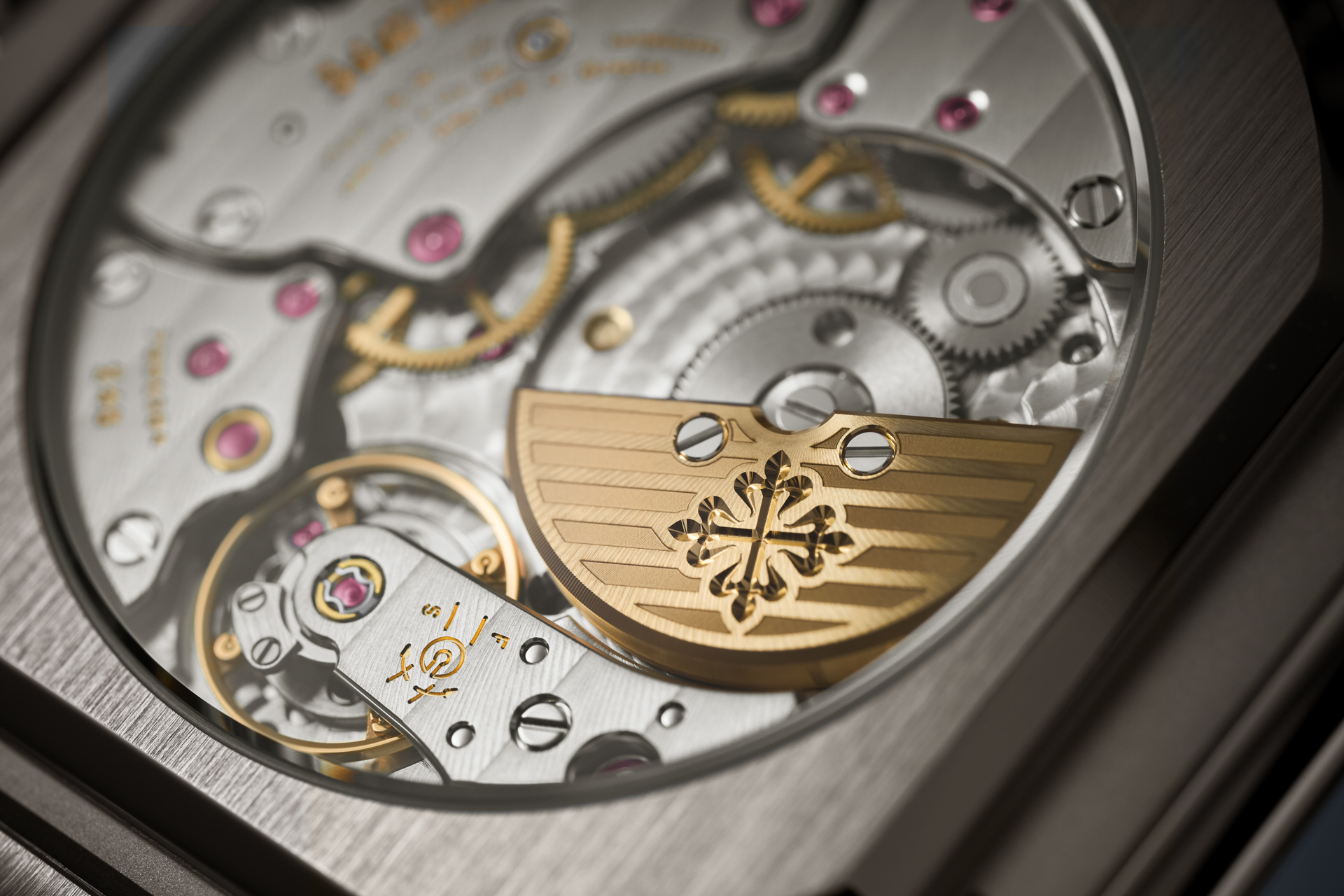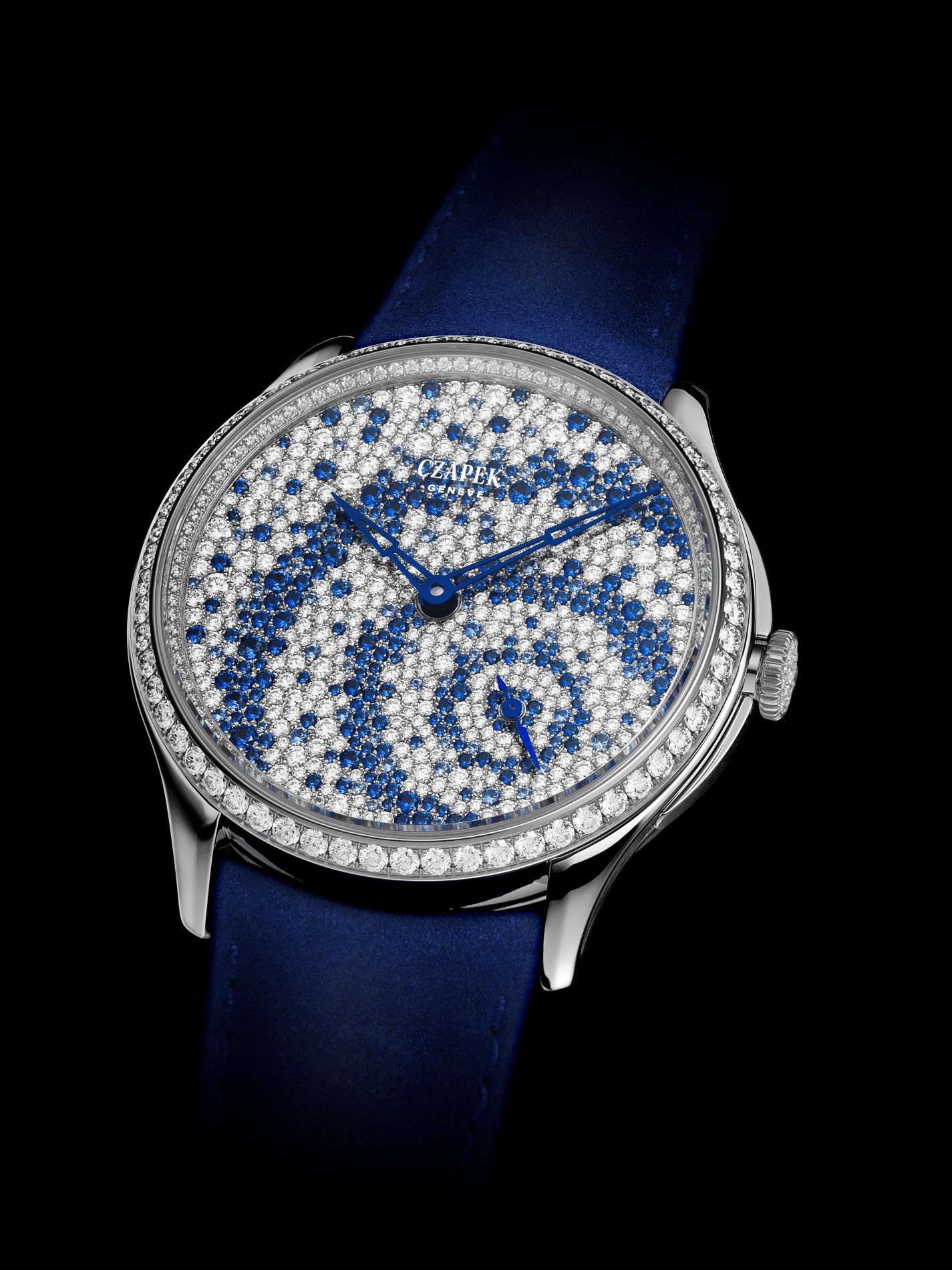To mark the birth of its new Cubitus collection, Patek Philippe is unveiling a completely new model with innovative displays combining a large-format instantaneous date and instantaneous moon phases and day of the week.
Endowed with a new movement for which six patent applications have been filed, the Cubitus Instantaneous Grand Date, Day and Moon Phases Reference 5822P-001 also stands out by its striking square-shaped platinum case with rounded corners – an exclusive design – its blue sunburst dial with horizontal relief embossing and its navy-blue strap in a composite material, embossed with a fabric motif. In sum, a unique new alliance of haute horlogerie, technical daring and sporting elegance.
The launch of a new Patek Philippe collection is a milestone in the company’s history and a cause for celebration. And what better way to honor it than by presenting it together with a new, exclusive complicated movement? To accompany the casual chic of the Cubitus design, the manufacture chose to highlight the “grand date” function, distinguished both by its legibility and its assertive air. Useful in everyday life, the large-format date –in its double aperture – is also ideally suited to the bold geometry of the Cubitus case and dial. But the development of an all-new movement uniting this function with moon phases and a day indicator required that Patek Philippe surmount a considerable number of technical and aesthetic challenges. In particular, it called for the design of a completely new large-date mechanism –the aim being, as in all the manufacture’s complications, to unite technical complexity with outstanding simplicity, practicality and safety in use.

A new metamorphosis for the renowned caliber 240
First essential: the slenderness of the movement, to guarantee the timeless elegance of the case. To deliver this exceptional finesse, despite the addition of a complex mechanism, Patek Philippe’s engineers decided to take as their base the acclaimed caliber 240 ultra-thin self-winding movement with a 22K gold off-center mini-rotor. This great classic of mechanical horology, introduced in 1977, is recognized as a cult movement, renowned for its slim profile, reliability and performance. It has proved its value and versatility in several versions with additional functions that now power numerous models in the current collection. It is found for example in the caliber 240 PS IRM C LU movement (249 parts) with power- reserve indicator at the 10:30 position, analog date and moon phases at 7 o’clock and small seconds at 4:30 equipping the Nautilus 5712 references since 2006. On the new Cubitus Reference 5822P-001, the aim was to offer – along with the large date indication at 12 o’clock and small seconds at 4:30 – a dual co-axial day display by a hand and moon phase by an aperture in a subsidiary dial at 7 o’clock. Thus was born the new caliber 240 PS CI J LU self-winding movement (353 parts), a perfect blend of tradition and innovation. Despite the addition of 104 more parts compared with the caliber 240 PS IRM C LU, the height of the movement increased by only 0.77 mm (4.76 mm versus 3.99 mm). In particular, for this purpose, the engineers re-worked the base movement by endowing it with an instantaneous-jump calendar mechanism for the display of a grand- date indication in a double aperture.
Simultaneous jumps in 18 milliseconds
If slender proportions were of the essence, so too was perfect legibility, a key requirement for a large date indication. To avoid any time lag between the different displays, Patek Philippe developed an instantaneous-jump mechanism, not only for the grand date but for the day and moon-phase indications. A large lever, the “main lever” driven by the 24-hour wheel controls all these changes. This wheel carries a cam that winds the main lever continuously. At midnight, the beak of the main lever drops from the top of the cam, released by its powerful spring. The main lever then engages –via various components –a tooth of the date star, a tooth of the day star and a tooth of the moon-phase star, to effect the change in these indications. Accordingly, every night at midnight, all these displays jump instantaneously and simultaneously in 18 milliseconds, using the energy accumulated throughout the day.

Coplanar disks for the grand date
To endow this timepiece with the sleekest and most elegant system possible for displaying the grand date, Patek Philippe’s engineers designed a caliber featuring coplanar disks (that is, disks positioned exactly on the same plane): a device that avoids any unaesthetic superposition. Each night at midnight, the energy supplied by the main lever is divided between two gear trains driving, respectively, the tens disk (with a double sequence of 0, 1, 2, 3) and the units disk (with digits from 0 to 9). Thanks to a patent taken up from the caliber 31-260 PS QL (launched in the in-line perpetual calendar Reference 5236 in 2021), this mechanism makes it possible to manage the jumps from 31 to 01 while maintaining the 1 digit stationary by means of gears with truncated teeth. An “anti-double-jump” system for the units, also patented in 2021, avoids any second change of the date in the event of a shock or during a correction.
Complex energy management
As the display of the grand date by means of two coplanar disks consumes copious energy, it was necessary to accumulate enough power to drive these two very large disks and have them jump instantly as well as the day and moon-phase indications. It was also important to ensure that the mechanism distributes this energy exactly according to the three different types of jump of the grand-date indication occurring over time. The first scenario is when only the units change (e.g. during the passage from 11 to 12) and where, consequently, only the units disk is moving. The second scenario is when the tens change during the month (e.g. during the passage from 09 to 10) which causes both disks to move (tens and units). And the third scenario, which occurs once a month, is the passage from 31 to 01, when only the tens disk is moving, while the units disk remains stationary.

Six patented technical innovations
To meet all these challenges, Patek Philippe’s engineers developed new technical solutions leading them to file six specific patent applications. In particular these innovations guarantee: perfect alignment of the grand-date numerals at all times in the two apertures; absence of any double jump of the tens during the change of the date from 31 to 01 or in the event of a shock, and the possibility of correcting all the indications (including the time and the day) at any hour of the day without risk of damaging the movement or disturbing the correct display of the information. These technical breakthroughs combine to optimize the reliability, legibility and ease of operation of the various functions, directly in line with Patek Philippe’s design philosophy of putting the user first. The movement is endowed with three correction push-pieces set into the flanks of the case, for the date, the day and the moon phases respectively. As this is what is known as a “simple” calendar, the owner must correct his or her timepiece on the first day of the months of March, May, July, October and December. The moon-phase display is so precise that it takes 122 years to deviate by a single day from the true lunar cycle. As to the rate accuracy of the new caliber 240 PS CI J LU, it meets all the strengthened criteria declared official by the manufacture in spring 2024, with a tolerance range of -1 and +2 seconds per 24 hours in compliance with the directives of the Patek Philippe Seal. A dial combining character with legibility The new Cubitus Instantaneous Grand Date, Day and Moon Phases Reference 5822P-001 presents a blue dial embellished with a sunburst motif and horizontal relief embossing. The grand date appears in a double aperture at 12 o’clock in an embossed beveled frame. The coaxial day and moon-phase indications at 7 o’clock and the asymmetric small seconds at 4:30 stand out in white on the blue ground. Legibility is further ensured by applied baton-style hour markers and rounded baton-style hour and minute hands, all in white gold with a luminescent coating that is white by day and glows green in the dark. The nobility of platinum The new Cubitus case in platinum is a two-part construction with lateral attachments, distinguished by its 45mm diameter and the elegant finesse of its profile (9.6 mm). Its characteristic design, a square with rounded corners, gains additional impact from contrasting finishes –vertical satin-brushed on the flat of the bezel and the front of the case, polished on the beveled sides of the bezel and the case flanks. Like all Patek Philippe’s platinum models, the new Reference 5822P-001 has a diamond (here, a baguette cut for the first time) set into the bezel at 6 o’clock. The transparent case back in sapphire crystal affords a private view of the new caliber 240 PS CI J LU movement, with its 22K gold off-center mini-rotor adorned with the same pattern of horizontal lines as the dial–a signature distinguishing the models in this collection. The watch’s blend of modern, casual chic with a technical edge continues through to a navy-blue strap with cream contrasting stitching in an ultra-resistant composite material embossed with a fabric motif. The platinum fold-over clasp is engraved with the name of the Cubitus collection. Patek Philippe also offers new Cubitus cufflinks in the collection, designed to match the watch, their white-gold frame echoing the shape of the case and centering a blue sunburst motif adorned with an embossed horizontal relief (205.9821G-001).

The six new patents for caliber 240 PS CI J LU
During the development of caliber 240 PS CI J LU Patek Philippe filed six new specific patent applications:
•Tangential brake (European patent application EP4328674) At the end of each month, while the date changes from 31 to 01, the unit must remain stationary. The energy therefore, instead of being distributed between the two wheel trains (tens and units) is transmitted entirely to the tens train. This tangential brake mechanism integrated into the tens train causes an artificial overconsumption during the passage from 3 to zero. By thus absorbing the surplus energy directed towards the tens disk, it makes it possible to avoid any double jump of the latter.
• Dual-lever correction system (patent application CH719977) This security system was designed for manual correction of the date using the corrector push-piece located at 10 o’clock during corrections from 9 to 10, from 19 to 20, from 29 to 30 and from 31 to 1, where one does not benefit, for the tens, from the energy of the instant jump. Thanks to the presence of a second lever (a flexible finger-piece ending the travel of the tens disk) this system makes it possible to ensure the jump of the tens at any time and regardless of the force of the pressure exerted on the corrector.
• Flexible day corrector (European patent application EP4246247) This system makes it possible to correct the day of the week at any time of the day, notably between 9:30 and 12 o’clock, when the corrector is blocked on the return by the click of the grand lever actuating the day star. This solution allows for a retractable corrector in a thickness that is insufficient to accommodate a pivoting click.
• Cam winding wheel with dual-function spring (European patent application EP4312083) Designed for a cam driven by the 24-hour wheel, this system of a winding wheel with a dual-function spring makes it possible to overcome a greater force of friction (torque) while ensuring the perfect precision of the date jump at midnight. A system of disconnecting gear fitted with a flexible finger-piece that retracts when the 24-hour cam strikes the beak of the grand lever also enables the user to adjust the time at any moment, backwards or forwards, passing midnight, without any risk of damaging the movement.
• Mechanism for positioning the disk indications & flexible blocking plate (patent applications CH720028 & EP4336273) On a large date display, the slightest visual lag between the tens and units would be displeasing to the eye. This new mechanism, comprising an eccentric and a flexible plate, makes it possible to adjust on each watch individually the position of the two disks at the time of casing-up, once the final dial has been fitted. In this way, the two indications are perfectly centered in their apertures, for optimal legibility. This system makes it possible to keep these positions tensioned and thus permanently conserved, so that they resist shocks during wear and remain perfectly aligned.
Patents taken over from caliber 31-260 PS QL
The new caliber 240 PS CI J LU incorporates two patents developed for the caliber 31-260 PS QL equipping the in-line perpetual calendar Reference 5236P-001 unveiled in 2021.
• Shock absorber and/or anti-double-jump mechanism for a watch movement (European patent application EP 3786724) This mechanism strengthens security as regards the date display and the perfect synchronization of the two disks by avoiding any second change of the date in the event of a shock or during a correction.
• Date: Switch from 31 to 01 (European patent EP3786723B1) This mechanism ensures that the unit remains in its position when the switch from the 31st to the 1st of the following month takes place. This is handled by a 31-point star from which two teeth were removed.









